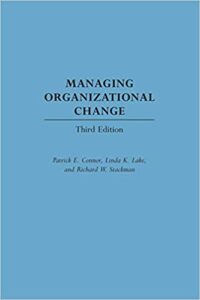Description
Test Bank For Organizational Change 3rd Edition By Patrick E. Connor
Chapter 5: Navigating Change Through Formal Structures and Systems
Test Bank
1. What are formal structures designed for?
@ Answer Location: Intro; Cognitive Domain: Application; Question Type: MC
*a. To support the strategic direction of the firm by enhancing efficiency and effectiveness
b. To clarify roles and responsibilities
c. To ensure accountability and oversight
d. To create a coherent organization chart
2. Which of the following is not an example of formal systems?
@ Answer Location: Intro; Cognitive Domain: Comprehension; Question Type: MC
a. Strategic planning, accounting and control systems
b. Pay and reward practices
c. Performance management
*d. Organizational culture
3. Some organizations do not require any formalization because they are so small.
@ Answer Location: Intro; Cognitive Domain: Analysis; Question Type: TF
a. True
*b. False
4. How does the degree of differentiation change over the life an organization?
@ Answer Location: Making Sense of Formal Structures and Systems; Cognitive Domain: Application; Question Type: MC
a. Differentiation generally remains stable throughout the life of the organization
*b. As the number of employees increases, there is greater differentiation
c. As an organization becomes more successful and profitable, there is a greater need to differentiate tasks
d. As a workforce becomes more embedded and cross-trained, the degree of differentiation diminishes
5. What is integration?
@ Answer Location: Making Sense of Formal Structures and Systems; Cognitive Domain: Application; Question Type: MC
a. How much one task overlaps with another
b. The degree in which each individual tasks fits in with the organization’s overall mission
c. The degree to which responsibility is meaningfully assigned instead of having unnecessary levels of management and bureaucracy
*d. The extent to which all disparate tasks and jobs are combined into a cohesive whole
6. What are common ways that larger, more complex companies are organized?
@ Answer Location: Making Sense of Formal Structures and Systems; Cognitive Domain: Application; Question Type: MC
a. Larger companies tend to be organized purely by function
b. Every product and category is integrated into each department to ensure integration
*c. Departments may be organized by product or geographic area, and there may be people who specialize, bringing together all parts of the organization
d. They consolidate all locations to manage all aspects of the company more closely from one entity
7. What part of structure does the chain of command reflect?
@ Answer Location: Making Sense of Formal Structures and Systems; Cognitive Domain: Analysis; Question Type: MC
*a. The formal power structure
b. The informal power structure
c. The organization’s culture
d. The change process
8. Organizations that have a more decentralized decision-making process tend to be structured in what way?
@ Answer Location: Making Sense of Formal Structures and Systems; Cognitive Domain: Analysis; Question Type: MC
a. Hierarchical
*b. Flat
c. Formal
d. Informal
9. The formality of an organization is defined by the extent to which structures and processes of the organization are written down and expected to be followed.
@ Answer Location: Making Sense of Formal Structures and Systems; Cognitive Domain: Comprehension; Question Type: TF
*a. True
b. False
10. Which of the following is not a characteristic of a mechanistic organization?
@ Answer Location: Impact of Uncertainty and Complexity on Formal Structures and Systems; Cognitive Domain: Comprehension; Question Type: MC
a. Tasks are broken down into separate parts
b. There is a narrow span of control
c. There is a straightforward planning process
*d. Communication is abundant and flows horizontally
11. Which of the following kinds of organizations is most likely to be mechanistic?
@ Answer Location: Impact of Uncertainty and Complexity on Formal Structures and Systems; Cognitive Domain: Comprehension; Question Type: MC
a. A tech start-up
b. A school
*c. A nuclear power plant
d. An architecture firm
12. In what kinds of industries would an organic organization work best?
@ Answer Location: Impact of Uncertainty and Complexity on Formal Structures and Systems; Cognitive Domain: Application; Question Type: SA
*a. Organic forms are best suited to creative fields, or in an environment where flexibility and adaptiveness are critical
13. As uncertainty ____________, the amount of information that needs to be processed between decision makers _______________.
@ Answer Location: Formal Structures and Systems From an Information Perspective; Cognitive Domain: Comprehension; Question Type: MC
a. Decreases, increases
b. Increases, decreases
*c. Increases, increases
d. Increases, stays the same
14. One way that organizations can reduce their information-processing challenges is by:
@ Answer Location: Formal Structures and Systems From an Information Perspective; Cognitive Domain: Application; Question Type: MC
a. Sending more emails
*b. Adding slack resources
c. Making departments more reliant on each other
d. Working harder and longer
15. What is the role of information systems?
@ Answer Location: Formal Structures and Systems From an Information Perspective; Cognitive Domain: Application; Question Type: MC
*a. To develop needed information and get it to the right people
b. To make sure all employees understand what’s going on in the organization
c. To keep employees accountable for mistakes they may be making
d. To develop annual reports for shareholders

Reviews
There are no reviews yet.